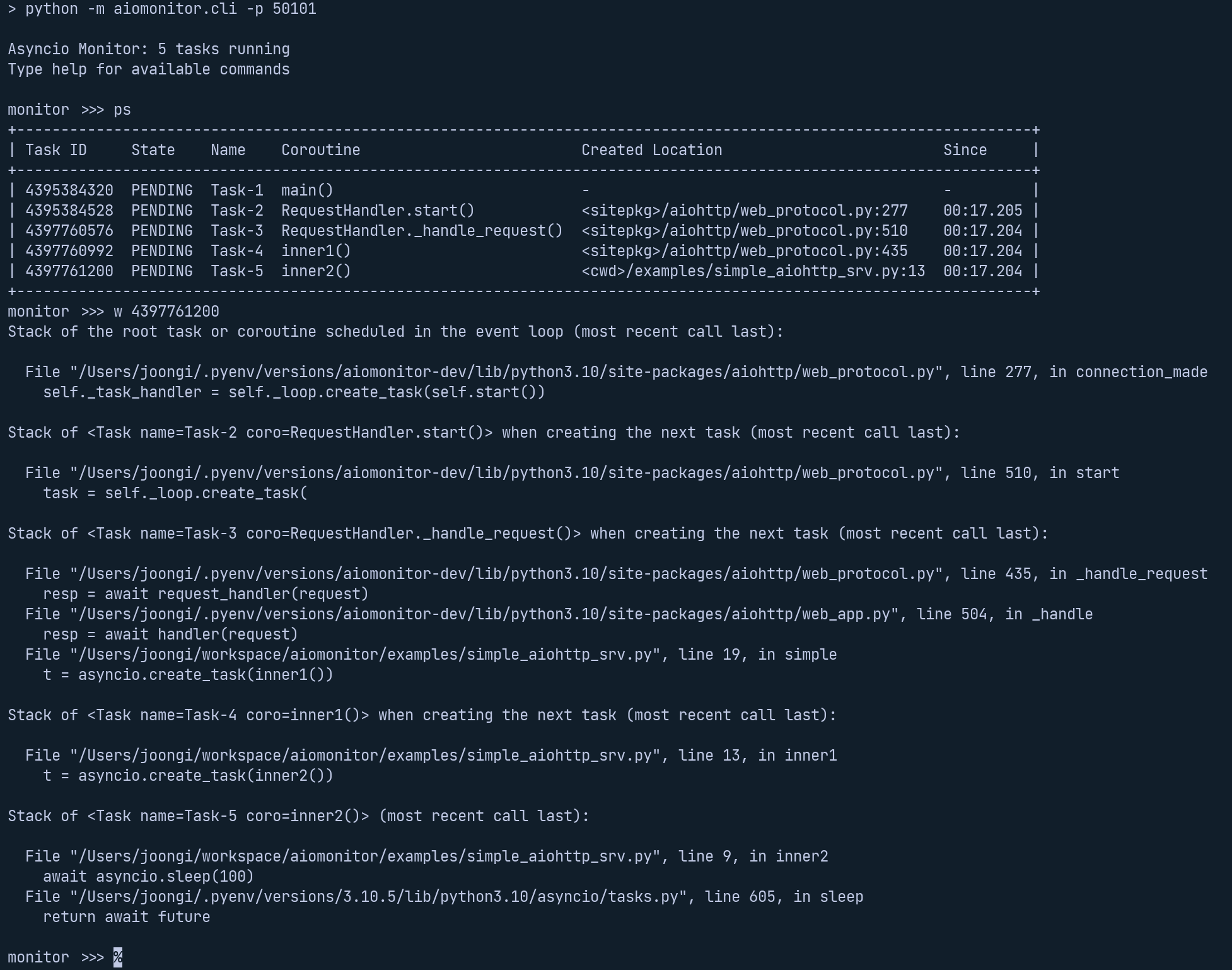aiomonitor-ng is a (temporary) fork of aiomonitor with support for Python 3.10+ and additional usability & debuggability improvements.
aiomonitor is a module that adds monitor and cli capabilities for asyncio applications. Idea and code were borrowed from curio project. Task monitor that runs concurrently to the asyncio loop (or fast drop-in replacement uvloop) in a separate thread as result monitor will work even if the event loop is blocked for some reason.
This library provides a python console using aioconsole module. It is possible to execute asynchronous commands inside your running application. Extensible with you own commands, in the style of the standard library's cmd module
Installation process is simple, just:
$ pip install aiomonitor-ng
Monitor has context manager interface:
import aiomonitor
loop = asyncio.get_event_loop()
with aiomonitor.start_monitor(loop=loop):
loop.run_forever()Now from separate terminal it is possible to connect to the application:
$ nc localhost 50101
To make arrow keys working properly you can use the rlwrap trick:
$ rlwrap nc localhost 50101
or the included python client:
$ python -m aiomonitor.cli
Let's create a simple aiohttp application, and see how aiomonitor can
be integrated with it.
import asyncio
import aiomonitor
from aiohttp import web
# Simple handler that returns response after 100s
async def simple(request):
loop = request.app.loop
print('Start sleeping')
await asyncio.sleep(100, loop=loop)
return web.Response(text="Simple answer")
loop = asyncio.get_event_loop()
# create application and register route
app = web.Application(loop=loop)
app.router.add_get('/simple', simple)
# it is possible to pass a dictionary with local variables
# to the python console environment
host, port = "localhost", 8090
locals_ = {"port": port, "host": host}
# init monitor just before run_app
with aiomonitor.start_monitor(loop=loop, locals=locals_):
# run application with built-in aiohttp run_app function
web.run_app(app, port=port, host=host)Let's save this code in file simple_srv.py, so we can run it with the following command:
$ python simple_srv.py ======== Running on http://localhost:8090 ======== (Press CTRL+C to quit)
And now one can connect to a running application from a separate terminal, with
the nc command, and aiomonitor will immediately respond with prompt:
$ nc localhost 50101 Asyncio Monitor: 1 tasks running Type help for commands monitor >>>
Note in order to make arrow keys and editing work properly just prepend command with rlwrap:
$ rlwrap nc localhost 50101
Now you can type commands, for instance, help:
monitor >>> help
Commands:
ps : Show task table
where taskid : Show stack frames for a task
cancel taskid : Cancel an indicated task
signal signame : Send a Unix signal
stacktrace : Print a stack trace from the event loop thread
console : Switch to async Python REPL
quit : Leave the monitor
aiomonitor also supports async python console inside a running event loop
so you can explore the state of your application:
monitor >>> console Python 3.5.2 (default, Oct 11 2016, 05:05:28) [GCC 4.2.1 Compatible Apple LLVM 8.0.0 (clang-800.0.38)] on darwin Type "help", "copyright", "credits" or "license" for more information. --- This console is running in an asyncio event loop. It allows you to wait for coroutines using the 'await' syntax. Try: await asyncio.sleep(1, result=3, loop=loop) --- >>> await asyncio.sleep(1, result=3, loop=loop)
To leave the console type exit():
>>> exit() monitor >>>
aiomonitor is very easy to extend with your own console commands.
class WebMonitor(aiomonitor.Monitor):
def do_hello(self, sin, sout, name=None):
"""Using the /hello GET interface
There is one optional argument, "name". This name argument must be
provided with proper URL excape codes, like %20 for spaces.
"""
name = '' if name is None else '/' + name
r = requests.get('http://localhost:8090/hello' + name)
sout.write(r.text + '\n')- Python 3.5+
- aioconsole
- uvloop (optional)
